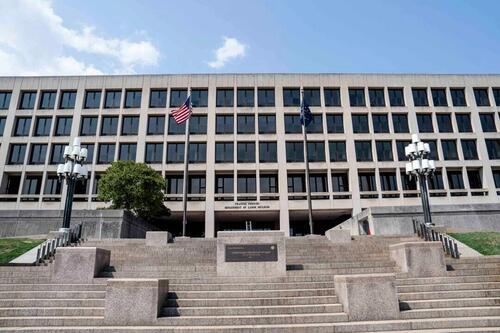Authored by Zachary Stieber via The Epoch Times (emphasis ours),
Some judges can be removed at will, rather than for cause, a federal judge said in a new Dec. 10 ruling as he also removed a layer of protection for the judges.
 The Department of Labor in Washington on Aug. 6, 2024. Madalina Vasiliu/The Epoch Times
The Department of Labor in Washington on Aug. 6, 2024. Madalina Vasiliu/The Epoch TimesNational Labor Relations Board (NLRB) administrative law judges have been protected in a complex scheme that requires the board to petition a different agency, the U.S. Merit Systems Protection Board, to remove the judges. Even if the protection board agrees, the NLRB can only act if “good cause” for removal is found.
Adding to the “byzantine process,” members of both boards can only be removed themselves for certain reasons, such as neglect of duty, U.S. District Judge Trevor McFadden wrote in the new decision.
The U.S. Constitution gives the president executive power, which includes, according to Congress and court rulings, the power to remove subordinates. The exceptions are for inferior officers and some boards.
In 2010, U.S. Supreme Court justices said that a scheme protecting Public Company Accounting Oversight Board officers was unconstitutional because it placed the president two layers away from removal. The Securities and Exchange Commission (SEC), which appointed the members, could only remove the members for good cause. SEC commissioners themselves could only be fired by the president for neglect of duty, malfeasance in office, or inefficiency.
“In short, two protective layers was one too many,” McFadden said. “So too here.”
The protection NLRB judges have “could result in federal officers pursuing unordained and perhaps unwise paths, with the only fear of reprisal shrouded in a maze of red tape,” the judge said. “Such attenuation from accountability was precisely what the Framers warned against when they rebuffed calls to fashion a plural executive.”
The NLRB said in court filings that the administrative law judges have less power than Public Company Accounting Oversight Board officers and that they are more easily removed than the officers. McFadden said the judges are “powerful actors in the Executive Branch” because they can manage cases without oversight, including granting applications for subpoenas, and that the easier removal does not change the multilayer removal scheme.
The Supreme Court ruling “was clear in its admonition: Officers of the United States cannot be insulated from the removal power by two or more levels of decisionmakers who themselves enjoy job protection,” the judge said. “To find otherwise would poison the soil of Article II and choke off accountability to the President. The removal restrictions are unconstitutional.”
The Supreme Court has not weighed in on the matter. The U.S. Court of Appeals for the Fifth Circuit has found SEC administrative law judges, which had similar protections to NLRB judges, were unconstitutionally protected. Three other circuit courts have found administrative law judge protections to be constitutional.
In two of those rulings, the courts “placed too much weight on the adjudicatory ‘functions’” of the judges, ignoring how the judges “were nonetheless exerting executive power, case by case,” McFadden said. The third ruling was reversed by the Supreme Court, on other grounds.
“That is a tenuous reed to sustain the NLRB’s position,” he said.
In a two-page order, McFadden said that NLRB judges can now be removed by the board itself, without input from the Merit Systems Protection Board.
The ruling came in a case brought by VHS Acquisition Subsidiary Number 7 Inc., which does business as Saint Vincent Hospital.
A spokeswoman for the NLRB declined to comment. A lawyer for the hospital, which is in Massachusetts, did not return an inquiry.
Source link

